
D
AF
as required,
MIC
fully cw (maximum)
0
SHIFT
to 12-o'clock
After completing one step, read the follow
ing step to determine whether the same test
equipment will be required. If not, remove the
test equipment (except dummy load and watt
meter, if connected) before proceeding.
Correct alignment requires that the ambient
temperature be the same as that of the trans
ceiver and test equipment, and that this tem
perature be held constant between 20 and
30
°C (68 - 86 °F).
If the transceiver is brought
into the shop from hot or cold air it should be
allowed some time for thermal equalization
with the environment before alignment.
Alignments must only be made with oscil
lator shields and circuit boards firmly affixed
in place. Only one extender board should be
installed at a time for access to the board being
aligned. Also, the test equipment must be thor
oughly warmed up before beginning.
Note:
Signal levels in
dB
referred to in alignment
are based on
0 dBµ= 0.5 µV.
Local Unit
Refer to the Local Unit Alignment Diagram
on page
3-7.
To prevent PLL unlock from inter
fering with the Local Unit alignment process,
connect
TP2004
to ground.
Remember to dis
connect
TP2004
when finished with alignment!
Reference Oscillator
D Connect the frequency counter to
J
P2001, and
the
RF
millivoltmeter to TP2005.
D If the counter frequency differs by more than 3
Hz from 5.242880 MHz, adjust the TCX0-4
trimmer (if the TCXO is installed) or TC2701.
D Confirm a level of at least 900 m V on the RF
millivoltmeter.
DDS 1 Check
3-2
D Tune the transceiver to 7 .045.1 MHz, and select
LSB mode.
D Connect the
RF
millivoltmeter to 02036,
pin
2, and confirm the RF millivoltmeter indicates
at least 110 m V.
DDS2Check
D Tune the transceiver to 7.045.1 MHz, and select
LSB mode.
D Connect the
RF
millivoltmeter to 02044,
pin
2, and confirm an indication of at least 65 m V.
PLL BPF
D Connect the
RF
millivoltmeter to TP2001.
D
Tune the transceiver to 7.005.66 MHz, and
select LSB mode.
D Adjust T2001 - T2003 alternately several
times for peak indicated
RF
voltage (at least
190 mV.)
Carrier Level Adjust
&
Frequency Check
D Connect
RF
millivoltmeter to TP2015.
D
Alternately adjust T2004 and T2005 several
times for peak indicated
RF
voltage ( at least
320 mV).
D Replace the
RF
millivoltmeter with a fre
quency counter.
D Select the indicated mode and frequency, ac
cording to table below, then set the
MIC &
RF
PWR
controls fully ccw (min.) and press the
MOX
button to transmit.
Mode
8.213.50
MHz
LSB
8.216.50
MHz
USB
8.215.80
MHz
cw
8.215.80
MHz
AM
D Confirm the carrier frequency is within ± 20 Hz
of the displayed counter frequency.
PLL Main Loop VCO
D
Connect the DC voltmeter to TP2013, then
adjust and check the VCO voltage according to
the table 1 shown at the top of the next page:
D
Tune the transceiver to 30.000.0 MHz, USB
mode, connect the
RF
voltmeter to 02048
pin
13, and confirm an level of more than 60 m V.
1st L.O. Output Level Check
D
Connect the
RF
millivoltmeter to TP2014.
D Tune the transceiver to 30.000.0 MHz, and
select USB mode. Confirm a level of at least
640 mV.
FT-840 Technical Supplement
Summary of Contents for FT-840
Page 10: ......
Page 22: ......
Page 44: ......
Page 60: ......
Page 62: ......
Page 64: ... N otes ...
Page 66: ... ...
Page 68: ... N otes ...
Page 70: ......
Page 72: ... ...
Page 74: ......
Page 76: ... N otes ...
Page 78: ......
Page 82: ......
Page 84: ......
Page 86: ......
Page 90: ...5 1 8 FT 840 Technical Supplement ...
Page 92: ......
Page 94: ...Notes ...
Page 96: ......
Page 100: ... ...
Page 102: ......
Page 104: ......
Page 106: ......
Page 108: ......
Page 110: ......
Page 114: ... ...
Page 116: ......
Page 118: ......
Page 120: ......
Page 124: ... N otes ...
Page 126: ......
Page 128: ......
Page 132: ......
Page 134: ......
Page 136: ......
Page 144: ......













































